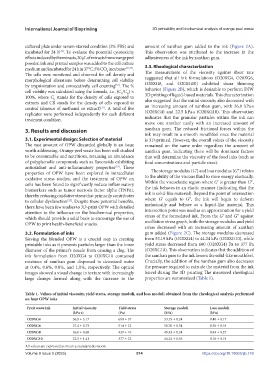Page 522 - IJB-9-5
P. 522
International Journal of Bioprinting 3D printability and biochemical analysis of orange peel waste
cultured plate under serum-starved condition (2% FBS) and amount of xanthan gum added to the ink (Figure 2A).
incubated for 24 h . To evaluate the potential cytotoxicity This observation was attributed to the increase in the
[32]
effects induced by the extracts, 20 μL of extracts from orange peel adhesiveness of the ink by xanthan gum.
powder, ink and printed samples was added to the cell culture
medium and incubated for 24 h in 37°C, 5% CO incubator [31,32] . 3.3. Rheological characterization
2
The cells were monitored and observed for cell density and The measurement of the viscosity against shear rate
morphological alterations before determining cell viability suggested that all ink formulations (O20XG4, O20XG6,
by trypsinization and consecutively, cell counting . The % O20XG8, and O20XG10) exhibited shear thinning
[31]
cell viability was calculated using the formula, i.e., (C /C ) × behavior (Figure 2B), which is desirable to perform DIW
B
S
100%, where C stands for the density of cells exposed to 3D printing of liquid-based materials. This characterization
S
extracts and CB stands for the density of cells exposed to also suggested that the initial viscosity also decreased with
control (absence of methanol or extract) . A total of five an increasing amount of xanthan gum, with 36.9 kPa·s
[31]
replicates were performed independently for each different (O20XG4) and 22.5 kPa·s (O20XG10). This observation
treatment condition. indicates that the granular particles within the ink can
move one another easily with an increased amount of
3. Results and discussion xanthan gum. The reduced frictional forces within the
ink may result in a smooth mouthfeel once the material
3.1. Experimental design: Selection of material is 3D-printed. However, the overall values of the viscosity
The vast amount of OPW discarded globally is an issue remained on the same order regardless the amount of
worth addressing. Orange peel waste has been well studied xanthan gum, indicating there will be dominant factors
to be consumable and nutritious, retaining an abundance that will determine the viscosity of the food inks (such as
of polyphenolic compounds such as flavonoids exhibiting food concentrations and particle sizes).
antioxidant and anti-inflammatory properties . These
[33]
properties of OPW have been explored in intracellular The storage modulus (G′) and loss modulus (G″) relates
oxidative stress studies, and the treatment of OPW on to the ability of the viscous fluid to store energy elastically.
cells has been found to significantly reduce inflammatory Within the viscoelastic region where G′ is greater than G″,
biomarkers such as tumor necrosis factor alpha (TNFα), the ink behaves in an elastic manner (indicating that the
thereby reducing oxidative stress that primarily contributes ink is solid-like material). Beyond the point of intersection
to cellular dysfunction . Despite these potential benefits, where G′ equals to G″, the ink will begin to deform
[33]
there have been few studies to 3D-print OPW with detailed inelastically and behave as a liquid-like material. This
attention to the influence on the biochemical properties, intersection point was used as an approximation for a yield
which should provide a solid basis to encourage the use of stress of the formulated ink. From the G′ and G″ against
OPW to print health-beneficial snacks. oscillation stress graph, both the storage modulus and yield
stress decreased with an increasing amount of xanthan
3.2. Formulation of inks gum added (Figure 2C). The storage modulus decreased
Sieving the blended OPW is a crucial step in creating from 53.19 kPa (O20XG4) to 44.24 kPa (O20XG10), while
printable inks as it prevents particles larger than the inner yield stress decreased from 680 (O20XG4) Pa to 377 Pa
diameter of the printer’s nozzle from causing a clog. The (O20XG10). This observation indicates that the addition of
ink formulation from O20XG4 to O20XG10 contained the xanthan gum to the ink lowers the solid-like mouthfeel.
mixtures of xanthan gum dispersed in deionized water Crucially, the addition of the xanthan gum also decreases
at 0.4%, 0.6%, 0.8%, and 1.0%, respectively. The optical the pressure required to extrude the material from the ink
images showed a visual change in texture with increasingly barrel during the 3D printing The measured rheological
large clumps formed along with the increase in the properties are summarized (Table 1).
Table 1. Values of initial viscosity, yield stress, storage moduli, and loss moduli obtained from the rheological analysis performed
on four OPW inks
Fruit waste ink Initial viscosity Yield stress Storage moduli Loss moduli
(kPa·s) (Pa) (kPa) (kPa)
O20XG4 36.9 ± 5.17 680 ± 37 53.19 ± 0.24 8.40 ± 0.17
O20XG6 27.4 ± 0.73 514 ± 22 50.70 ± 0.34 8.38 ± 0.18
O20XG8 26.0 ± 0.68 429 ± 10 49.43 ± 0.24 8.84 ± 0.27
O20XG10 22.5 ± 1.41 377 ± 22 44.24 ± 0.56 8.10 ± 0.19
All values are expressed as mean ± standard deviation.
Volume 9 Issue 5 (2023) 514 https://doi.org/10.18063/ijb.776

